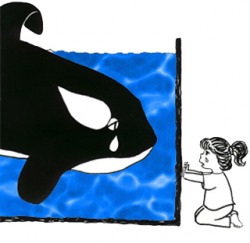Whales in Aquariums
Just like zoos and circuses claim that they are keeping the animals for educational purposes, Aquariums do too. While it may be thrilling for children to see whales and dolphins at a close range, it’s not worth the inaccurate or misleading information that the aquarium usually provides. The only education our children are gaining is that “animals (are) objects and servants to human needs and desires, rather than an important part of an ecosystem with their own intrinsic value and dignity” (The Vancouver Aquarium’s Four Great Myths). The aquariums also claim that they are using the animals for research, but like the animals in circuses and zoos, the animals don’t act the same as they would in the wild. The research conducted gains little to no useful information compared to the research conducted in the wild. “For example, part of the (Vancouver) aquarium’s aquaculture lab is dedicated to breeding four species of seahorses that are not for public display, but to sell as aphrodisiacs in Asia. The aquarium calls this commercial enterprise ‘conservation research’” (The Vancouver Aquarium’s Four Myths). Breeding animals to sell them for profit is most definitely not a noble cause to keep animals suffering behind glass walls.
The aquariums also breed their animals for further profit from spectators and to keep their aquariums full. “Six out of seven baby whales and dolphins have died at the aquarium, but even the grisly spectacle of a dead baby whale is a huge draw for visitors. When Bjossa gave birth to her third baby orca -- delivered to the screams of excited schoolchildren bused in for the event -- the infant died eight minutes later. He was left dead on the bottom of the tank for 5 days, while aquarium visitors lined up all the way to the parking lot to gawk at the “new” dead baby whale” (The Vancouver Aquarium’s Four Myths). Successful Breeding of whales and dolphins rarely occurs in captivity, so the aquariums have to resort to buying more animals to refill their tanks. More animals captured from the wild, forced to perform tricks at the hands of a hungry profit machine. “The aquarium brings in more than $22 million a year in revenues, and that’s just the “non-profit” society” (The Vancouver Aquarium’s Four Myths).
Susan Sherwin, campaigns manager for the World Society for the Protection of Animals made a good point in stating, "It's time to take a good, hard, honest look at the captive display industry and see it for what it truly is rather than what we want it to be. Let's start looking at this from the marine mammals' point of view instead of our own."
The aquariums also breed their animals for further profit from spectators and to keep their aquariums full. “Six out of seven baby whales and dolphins have died at the aquarium, but even the grisly spectacle of a dead baby whale is a huge draw for visitors. When Bjossa gave birth to her third baby orca -- delivered to the screams of excited schoolchildren bused in for the event -- the infant died eight minutes later. He was left dead on the bottom of the tank for 5 days, while aquarium visitors lined up all the way to the parking lot to gawk at the “new” dead baby whale” (The Vancouver Aquarium’s Four Myths). Successful Breeding of whales and dolphins rarely occurs in captivity, so the aquariums have to resort to buying more animals to refill their tanks. More animals captured from the wild, forced to perform tricks at the hands of a hungry profit machine. “The aquarium brings in more than $22 million a year in revenues, and that’s just the “non-profit” society” (The Vancouver Aquarium’s Four Myths).
Susan Sherwin, campaigns manager for the World Society for the Protection of Animals made a good point in stating, "It's time to take a good, hard, honest look at the captive display industry and see it for what it truly is rather than what we want it to be. Let's start looking at this from the marine mammals' point of view instead of our own."


